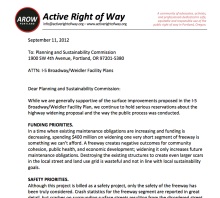
Active Right of Way (AROW), an all-volunteer transportation activism group, is expressing “serious reservations” with the Draft N/NE Quadrant and I-5 Broadway/Weidler Facility Plans. The project is a collaboration between the City of Portland and the State of Oregon that will spend $400 million to widen I-5 through the Rose Quarter and make a number of changes to adjacent surface streets. The group summed up their concerns with the project in a three page letter (PDF) sent to the City’s Planning and Sustainability Commission last week.
AROW opposes the project for several reasons. First among them are claims that the project doesn’t align with the right funding and safety priorities. The letter was signed by AROW leaders Steve Bozzone (who’s also a Willamette Pedestrian Coalition board member) and Alexis Grant. Below are some excerpts from their letter…
On funding:
“In a time when existing maintenance obligations are increasing and funding is decreasing, spending $400 million on widening one very short segment of freeway is something we can’t afford. A freeway creates negative outcomes for community cohesion, public health, and economic development; widening it only increases future maintenance obligations. Destroying the existing structures to create even larger scars in the local street and land use grid is wasteful and not in line with local sustainability goals.”
On safety:
“Although this project is billed as a safety project, only the safety of the freeway has been truly considered. Crash statistics for the freeway segment are reported in great detail, but crashes on surrounding surface streets resulting from the disordered street system created by the off ramps, the chaotic driving due to congestion, and the speed of entrance and exit to the freeway were never mentioned. In particular, the effect of the freeway’s presence on bicycle and pedestrian travel was discussed only conceptually. The result is to give high weight to what are usually minor freeway crashes, while minimizing the importance of surface street safety as highlighted in Metro’s State of Safety report. If safety is the true priority, we request that surface improvements be prioritized over freeway expansion.“
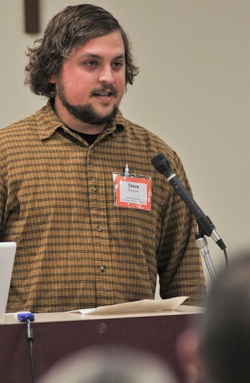
project meeting last year.
(Photo © J. Maus/BikePortland)
On the public process:
“The public process failed to create an inclusive committee or process, and did not adequately represent neighborhood-level stakeholders. While developers and business owners were well represented, the residents of adjacent neighborhoods and those displaced by the original Memorial Coliseum & I-5 projects, were not part of the public process… The I-5 Freeway, Memorial Coliseum and Emanuel Hospital have brought serious environmental burdens on Albina which must be addressed. We do not find the highway elements of this proposal to be consistent with the feedback and concerns of the neighborhoods impacted by the highway.”
On public health:
“There is no getting around how toxic and detrimental I-5 is to our city’s health. The highway contributes to our city’s poor air quality and high asthma rates. The large concrete cover required by a freeway increases surface air temperature and reduces land available for parks and greenways. Highway off-ramps are dangerous for people traveling in the area, particularly people walking and biking, and increase injury and death due to traffic behavior. None of these public health concerns were taken into account in this process. We are not convinced destroying the current bridge structures and widening the highway to allow more cars in the neighborhood will provide a true benefit for the public good.”
On land use:
“The Rose Quarter is an economic hub for the city and the amount of surface activity and transit is intense. Portland has made a significant investment in transit in the area with 4 MAX lines and a dozen bus lines meeting at the transit center, alongside the new Eastside Streetcar loop running along Broadway/Weidler. The corridor is a critical link for bicycle and pedestrian traffic and the Rose Quarter neighborhood is designated a Pedestrian District in the Transportation System Plan. We do not believe highway expansion is appropriate for supporting the type of walkable and vibrant corridor envisioned by residents and by the N/NE Quadrant Plan as a whole.”

light orange are new shoulders.
In addition to adding auxiliary lanes and widening shoulders of I-5, this project also comes with a host of proposed surface street improvements. However, activists worry that given the lack of funding, the freeway widening will be funded first while changes to surface streets — some of them which will improve bikeway access — might never come to fruition. On that note, Bozzone and Grant are urging the Planning Commission and Portland City Council to, “fast track the surface improvements and put on hold the highway-widening proposal.”
ODOT’s primary focus on widening I-5 through our city simply to relieve congestion caused me great concern at the outset of this project’s public process back in December of 2010. While surface street changes and other pieces of window dressing have been added — and while ODOT likes to frame this as a “safety” issue — this project is about expanding freeway capacity so that more cars and trucks can roar through the heart of our city. Is this really the type of project Portland stands for? I’m grateful that at least AROW has spoken up.
If you’d like to voice your opinion about this project, there aren’t many opportunities left. The Project Stakeholder Committee will hold a work session on September 25th; but they won’t take public testimony. Their recommendation is tentatively set for a public hearing at Portland City Council on October 25th. The public is welcome to testify and share thoughts with City Commissioners at that time.
— More on the N/NE Quadrant Plan here. Read AROW’s complete letter here (PDF).


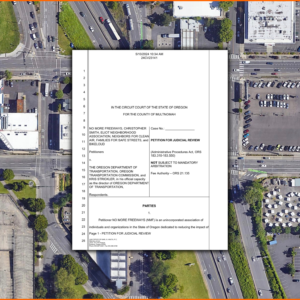
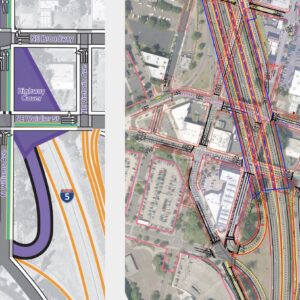

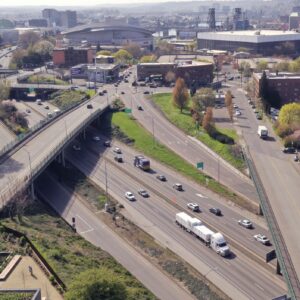
Thanks for reading.
BikePortland has served this community with independent community journalism since 2005. We rely on subscriptions from readers like you to survive. Your financial support is vital in keeping this valuable resource alive and well.
Please subscribe today to strengthen and expand our work.
These are great points. How much weight does a letter from an advocacy group like this carry in the decision-making process?
That depends on a lot of factors… But mostly it has to do with how many people will take the message and amplify it by calling and emailing decision makers. It’s not who signs the letter, it’s how many people it resonates with and whether or not they become involved/get activated too.
The first and easiest step in getting involved/activated is to email your thoughts to the following addresses:
mayorsam@portlandoregon.gov, amanda@portlandoregon.gov, randy@portlandoregon.gov, nick@portlandoregon.gov, dan@portlandoregon.gov
Be sure to use the phrase “Draft N/NE Quadrant and I-5 Broadway/Weidler Facility Plans” and reference the “Active Right of Way open letter dated September 11, 2012” or attach the PDF of the letter.
The volunteers with AROW do great work for our community! Have they earned an Alice Award yet?
Stop the widening of I-5!
Seconded – well done, AROW!
Wow, imagine the bike network $400 million could buy. Instead we’re just going to buy more traffic with $400m. We’ll never learn.
Unfortunately it is even worse than that. It is called stranded assets. Expanding a freeway in these times is beyond nuts.
We should be investing in infrastructure that will do us some good when the cheap oil and CO2-accommodating atmosphere are distant memories.
Great work, Steve and Alexis. Thanks!
Could someone please post emails/other contact info for how concerned community members such as myself could voice support for this letter? Thanks!
The Planning and Sustainability Commission hearing for this project is closed, with their recommendation to Council being discussed next Tuesday evening. The project will then head to City Council in late October, where you’d want to direct your testimony/comments.
So you’re saying that we should email
“Mayor Sam Adams” , amanda@portlandoregon.gov, randy@portlandoregon.gov, “Nick Fish” , dan@portlandoregon.gov
about this issue? Thanks! Done! Attached the PDF of the letter too.
oops, Sam Adams’ email is mayorsam@portlandoregon.gov .
and Nick’s email is nick@portlandoregon.gov . Sorry for the HTML fail!
wow, AROW is awesome and I’m so thankful to have a group like that take some action against big brother…
I will never understand how people can rage over $900,000 for huge amount of bicycle paths that actually reduce traffic, but then be fine with spending $400,000,000 on a tiny section of freeway.
…section of freeway that INCREASES traffic capacity, which then increases traffic use, which then reinstates the previous congestion problem and associated “safety” issues…the never-ending cycle (shame to use that word, but oh well).
amazing that two unpaid “activists” were able to create such an articulate and persuasive letter. I still checked the BTA blog and my many BTA emails and couldn’t find anything in them about this project.
makes you wonder….
AROW is the closest thing Portland has to a visionary, rabble-rousing transportation activist group. The BTA does a great job of building consensus around already-pretty-popular solutions. But, we also need another organization that pushes for faster, better, more radical changes. If AROW becomes that group, AROW can lay the groundwork and rally the troops to show politicians that there’s support for ideas that ruffle feathers. Then the BTA can come in once such an idea has significant support and compromise and horse-trade in order to get it implemented in the halls of power. Support AROW!
All over anti-CRC advocacy sites we were warned to expect that with the increased traffic load from an expanded bridge we would “need” to widen I-5 in this area.
So let’s tell the truth: the true cost of the CRC is the total cost of the bridge project itself PLUS every widening project needed to allow the CRC to function at its peak traffic load.
There is no pressing need for this project without the new CRC bridge.
Therefore each attached/adjacent project is part of the total effective cost of the CRC project.
Let’m shove that +$6billion price tag up their pipe and smoke it.
Agreed. Another reason to put a spike through the CRC. If that gets built there will be incredible pressure to get this project pushed through.
From what I’ve seen of the draft N/NE Quadrant Plan, I think it actually looks pretty good from a cycylist’s perspective. It increases the options for cycling and walking especially in an east-west direction over I-5. Hancock and Clackamas overcrossings would be two new crossings. So many people complain about Broadway and Weidler, I have to give the developers of the plan credit for trying to fix those deficiencies.
I’d guess that half the total cost of the project is for the freeway widening component of the project and half is for surface street improvements including lots of things that will benefit cyclists.
I ride my bike a lot (commuting almost every day), but there are some things that I must realistically use my car for. I’m willing to accept, or even support, some improvements to the street system that improve things for motorists and truckers as long as there’s also a significant benefit to bicyclists and pedestrians. I’d also prefer greater capacity on freeways to serve trucks and motorists who have no choice than to have increased traffic (especially frustrated, in-a-hurry motorists) on streets where I’m riding my bike.
If they don’t build the good stuff along with the freeway widening component, I’d raise a stink, but I don’t automatically condemn every plan and project that improves conditons for motor vehicles. After all, I do use one.
Nicely said, J_R. This project appears to be targeting obvious bottlenecks. Decreasing congestion on I-5 may reduce sneaker traffic on adjacent streets like Interstate and Vancouver/Williams.
Increasing freeway capacity *may* reduce sneaker traffic for a year or two, but once induced demand fills up the capacity, the sneaker traffic will be back. And we’ll have an even bigger dirty, polluting freeway through the center of our city. Will we then need to widen the Marquam, and the Terwilliger Curves, and the whole rest of I-5? Open your pocket books!
And I own and use a car too. I just don’t think widening freeways at great expense when our City’s official goals are to *reduce* motor vehicle traffic makes any sense at all. And I don’t want to pay for it.
I don’t think that induced demand is going to fill capacity, though I’ll grant you that it may be a factor. I think that when the economy starts growing at a faster rate and unemployment numbers start to drop, there will be even more car and truck traffic using this corridor. I’d prefer that traffic be compartmentalized there, with increased capacity, rather than inducing increased traffic on secondary routes where I might ride my bike. I don’t mind paying for that.
Are you making the connection that the huge amount of money going towards freeway widening is money that therefore can’t be used for bike infrastructure?
Yea, I understand that.
OK, I guess we have different ideas for what government should prioritize. Cheers!
We may be in agreement more often than not. Ride safe.
Induced demand does fill capacity. Every time we add more lanes to the freeways, it enables more sprawling housing on the fringes. If we don’t add capacity, the freeway will stay congested, and fewer people will desire to build on the fringes, knowing that they have to deal with such an extreme commute. This will lead to denser infill development, which will encourage more cycling and transit use. It may not seem like it, but these are the projects that determine what our city will look like in the future. Do we want to be Seattle, or Vancouver BC?
I think that you may be under estimating what some people will endure to not live in the city.
Oh, I understand, and this is precisely why we cannot expand freeways. They are going to fill the space, so we must limit the space they can fill, and provide transportation options that pollute less.
You’re right–some people won’t change their mind about where to live, but some *will*.
I think there are two undesirable scenarios/outcomes conceivable here.
(1) past trends continue; induced demand is alive and well; people continue buying more cars and driving more miles with no apparent end in sight.
(2) auto saturation is reached. For various reasons people stop adding cars to their fleets and driving more miles every year; we discover that cars don’t automatically clog up everything as they used to, especially when we expand freeway capacity, unmindful of the fact that the world is changing. We end up with lots of excess lane miles as automobility is scaled back.
I know which I think is more likely, but I know that neither serves our collective needs going forward. I’m super impressed with AROW for standing up to this nonsense, and extremely disappointed in the lack of imagination displayed by pretty much everyone else who seems to be signing off on this obsolete approach to wasting money and resources we don’t have.
Precisely. Increasing freeway capacity is always just a temporary relief valve.
J_R,
The main priority for funding in this project (and btw, no money is on the table yet) is the freeway widening. There is not a strong of commitment to fund the surface street stuff as their is the fwy widening. ODOT has wanted to expand this freeway for a very long time and they saw an opportunity to make it look a little more “eco” by attaching their plans to the N/NE Quadrant project and partnering with the City of Portland.
You’re kind of wrong on this, JM. The majority of the surface road improvements will have to go in with the freeway widening and interchange fixes. Without them, the interchanges themselves wouldn’t work. So I think it’s disingenuous to paint this as just a “freeway first” project. The City and ODOT worked pretty hard together on this thing because the two systems (freeway and surface streets) are inextricably linked. (That said, there are a couple of items we’ll need to keep after ’em on – particularly the Clackamas Street overcrossing).
Jonathan is right on the money. The first public design charette began with a presentation on flying diamond freeway ramp designs. This was a highway project from the very start, and any questioning of this priority was met with chuckles from ODOT staff.
Staff successfully bike/ped-washed this project — they knew what they were doing, they had to get buy-in from this demographic in order to proceed with freeway widening.
We don’t have to demolish good bridges structures and widen a freeway to improve conditions for pedestrians and cyclists in the Rose Quarter. If we were serious about surface-level safety improvements, we would remove or relocate the ramps for the greatest safety gain. But this is a highway project, surface improvements were essentially a “bonus” meant to draw buy-in from those who would normally oppose such a project.
As a Builder By Bike, I have found that I-84 and I-5 to be the bane of my existence.
Yet highway infrastructure also makes your business possible.
Oh, please.
You really think Chris couldn’t find 2x4s or nails if/when freeways & oil disappeared? How do you think we built houses here in Oregon before oil and the interstate highway system? I-205 was only built in the sixties. Most of our houses were built long before our freeways.
Percent of freight
(mode, tons/mile, percent)
Truck 1,293,326 28.50%
Railroad 1,733,777 38.21%
Truck freight is only profitable due to massive government subsidy.
oops: ton-miles in millions.
“…Big-rig trucks have been effectively subsidized for decades—by as much as 40%, according to some independent highway cost allocation studies.
Subsidizing truckers who get to expense their right-of-way costs while railroads must capitalize theirs allows truckers to charge less than they would if they had to pay their full share of the government-owned, -operated, and -maintained highways they use. Railroads are forced to reflect the trucking subsidy in the rates they charge to move competitive traffic.
With the exception of some public-private partnerships, railroads put up their own (stockholders’) capital. So, if we are to believe the GOP, they are all for subsidizing motor carriers, while punishing railroads and their customers.”
http://www.railwayage.com/index.php/blogs/larry-kaufman/rnc-a-little-hypocrisy-goes-too-far.html?channel=#.UFtLYPuK9UA
The speed and reliability of the trucking industry is what cements it as our current freight paradigm.
Other methods are better in ways too numerous times mention but the reliable speed of trucking freight has allowed every company that deals in physical goods to reduce or eliminate costs of: warehouse stock that has not arrived, warehouse ownership, taxes and employees that manage them.
Until our antiquated rail system, and or something better, can compete with that efficiency advantage we are stuck with trucks.
The only advantage to the recent large increase in trucking is that it is drowning out and replacing the disturbingly accurate stereotype of older truckers that hate our non-automotive way of life and harbor too much of the cowboy/vigilante mindset. While thousands of less experienced drivers is worse at least they seem to harbor less fervent animosity towards cyclists and pedestrians.
Let’s tear out I-5!
Here, here, Gregg!
Mark my words we WILL tear out I-5 eventually. Why wait and, most definitely, why expand?
The biggest transportation problem we have is that we do not require users to pay the appropriate costs. Carbon emissions, crashes, health costs, enforcement, facility maintenance, etc. We need a $5 per gallon gas tax. That will cause people to make appropriate choices.
Our current system is like an all you can eat buffet. We consume too much and wonder why we are obese. Until we address the cost issue, we can’t really change the outcome. Refusing to undertake projects that have any roadway expansion component, even with safety and improvements, is missing the point. Look at the overall project. I still see overwhelming positive on this one.
“We need a $5 per gallon gas tax.
… Look at the overall project. I still see overwhelming positive on this one.”
I’m with you on the need for a real gasoline tax, but ‘overwhelming positive’? Can you explain.
The positve aspects I see for this plan include: higher density mixed use development in the Lloyd District area that can lead to more walking between mixed uses; plenty of new bouelvards in the area that are better for pedestrians and bicyclists; new connections over I-5 at Hancock and Clackamas that will let bicyclists avoid the high traffic arterials (e.g. Weidler) that connect with I-5; better connections between the Eastbank Esplanade and Interstate; opportunities to connect with Sullivans Gulch trail. Look at page 26 of the N/NE Quadrant Plan. The Vancouver-Hancock connection would completely eliminate the Broadway/Flint problems, too.
Also, I still think that providing adequate capacity and improving safety for motorists and trucks using I-5 keeps motorists off the routes where I’m biking. I think is worthwhile mproving safety by providing better shoulders and better merging on a freeway. OK, maybe it’s increasing freeway capacity, too. I don’t begrudge motorists a safer system just as I hope reasonable motorists won’t begrudge bicyclists a safer system, too.
Targeting the energy source, fuel/electricity, is useless.
We need to target the actual damage caused by vehicles which is weight per axle per mile. This ultimately how the much more destructive truck industry is charged and is how most sustainable toll roads bridges are charging.
Charging by weight reduces the total road system wear DIRECTLY while simultaneously reducing our national transportation energy use.
Charging by distance reduces use. This DIRECTLY reduces wear and reduces utilized capacity versus total capacity eliminating the “need” to build more capacity.
I’m a bit foggy on the per axle bit; from a pure science standpoint I’d think that weight distributed across more wheels would put less point impact pressure on the road surface thus reducing damage.
Make it a race issue. That’ll delay it a few years. Where are the African-American church activists on adding pollution to the neighborhood.
What is the problem with having less bumper-to-bumper traffic through that area? Fewer idling cars = less pollution.
It’s disingenuous to claim that increasing highway capacity only leads to more cars filling that capacity and ending up as jammed as before.
I bike and I drive and own a car. I live in NE PDX and have worked in Beaverton or Hillsboro for over a decade. I have biked, driven, and taken the MAX out over the years. All of the improvements (re-worked 217 interchange, extra lanes, etc.) to Highway 26 westbound have made a MASSIVE improvement in the traffic going out.
It used to take longer just to get to Murray 10 years ago than it does to get to Cornelius Pass now.
“It’s disingenuous to claim that increasing highway capacity only leads to more cars filling that capacity and ending up as jammed as before.”
Maybe you should read up a little on the concept of induced demand. It is not something bikey folks’ imagine, or dreamed up to make car drivers’ lives less enjoyable.
Here’s a start: http://en.wikipedia.org/wiki/Induced_demand
You might also note the inverse (mentioned in the article linked to): reduced demand:
“Just as increasing road capacity reduces the cost of travel and thus increases demand, the reverse is also true – decreasing road capacity increases the cost of travel, so demand is reduced. This observation, for which there is much empirical evidence, has been called Disappearing Traffic, also traffic evaporation or traffic suppression. So the closure of a road or reduction in its capacity (e.g. reducing the number of available lanes) will result in the adjustment of traveller behaviour to compensate – for example, people might stop making particular trips, condense multiple trips into one, retime their trips to a less congested time, or switch to public transport, walking or bicycling, depending upon the values of those trips or of the schedule delay they experience.”
“It used to take longer just to get to Murray 10 years ago than it does to get to Cornelius Pass now.”
That may be true. Around these parts folks are in fact driving less of late. As I noted above, induced demand isn’t the only way to look at this problem. Other factors may well soon overwhelm this well established relationship in the world of transportation planning.
But just because your commute to Murray is faster today doesn’t ipso facto mean that it was the expansion of roadways that produced that effect, or that we should keep doing it because other factors have displaced induced demand as the primary unintended consequence of road widening.
I was driving before, during, and after that 217 construction and while there may have been larger socioeconomic factors that greatly reduced traffic through that area, the new interchange clearly had a major effect.
“the new interchange clearly had a major effect.”
I don’t think anyone’s arguing that these projects don’t have ‘a major effect.’ The question in my mind is what are those effects, all of them? How long to they last? Do any of them cancel each other?
Do they give people the impression that driving that route works better than it did before? If so, do more people use it? How long until the previous equilibrium is reached? How do we back out of the habituation to drive more that easing congestion predictably has? I doubt you would say that an upgraded 217 resulted in a decrease in the aggregate amount of driving, so then, presumably, the win is to the drivers’ convenience, and the loss is to everyone else, present and future?
I’ve found myself on I-5 South of Portland on and off for the past 35 years. Lately I’d have to say that the worst traffic seems to me to occur around 217 and the I-5/205 junction.
Hold that thought. Let’s check back on the Hwy 26 changes in 15 years.
” Let’s check back … in 15 years.”
15 years?
In 15 years we are going to have lots of other, and more interesting things to be worrying about than freeway interchange dynamics. 15 years? I predict grass will be growing in the passing lanes.
I was responding to Aaron’s post about the Hwy 26 improvements, not to your post. I agree that widening roads has a temporary effect, which is eventually nullified by the expansion at the end of the newly widened road. People who wouldn’t have moved west when the evening commute was an hour long are now willing to live there now since the drive has been sped up considerably, which will eventually fill up Hwy 26 again.
Even ignoring induced demand, which approach do you think would be more effective at reducing air pollution? Adding freeway capacity, or using the same money to expand light rail along the same route? What about adding bike lanes, or other projects that encourage people to live closer to their jobs?
Surprise! Surprise! NOT. Jefferson Smith has said the CRC will lead to decades of highway building. Planned Rose Q widening hasn’t been a secret. If Clackamas and Clark counties can vote down light rail, why can’t we vote down freeway expansion in the middle of the city when by law we’re supposed to be reducing greenhouse gases?
Portland has gone to H*ll in a handbasket, unless one’s priorities are beer, and beer, and beer, and restaurants with the latest greatest in freshly killed and grilled animal flesh.
007 — Rose Quarter widening was a secret.
ODOT started working on it sometime around 2007.
It was never shown to the public until the first inner NE quadrant open house in about December 2010.
At that open house, an ODOT guy mentioned to me that they were going to widen it, I asked how long it had been in the works, why it hadn’t had any public discussion, etc., and that’s what he told me.
Thanks to Steve and Alexis for serving as the Public Opposition to this project. Write your letters, kids!
Ted Buehler
Please join the PDX Bike Swarm this Friday for Civil Discobedience. We will be using power (bikes, dance and music) to highlight the madness of our inter-urban freeway occupations and their corresponding noise pollution. Bring your awesome and, if you like, an FM Boombox. http://shift2bikes.org/cal/#28-3313